plinius secundus gaius pliny elder (15 Ergebnisse)
FeedbackSuchfilter
Produktart
- Alle Product Types
- Bücher (13)
- Magazine & Zeitschriften (Keine weiteren Ergebnisse entsprechen dieser Verfeinerung)
- Comics (Keine weiteren Ergebnisse entsprechen dieser Verfeinerung)
- Noten (Keine weiteren Ergebnisse entsprechen dieser Verfeinerung)
- Kunst, Grafik & Poster (2)
- Fotografien (Keine weiteren Ergebnisse entsprechen dieser Verfeinerung)
- Karten (Keine weiteren Ergebnisse entsprechen dieser Verfeinerung)
- Manuskripte & Papierantiquitäten (Keine weiteren Ergebnisse entsprechen dieser Verfeinerung)
Zustand
Einband
Weitere Eigenschaften
- Erstausgabe (3)
- Signiert (1)
- Schutzumschlag (Keine weiteren Ergebnisse entsprechen dieser Verfeinerung)
- Angebotsfoto (14)
Sprache (2)
Gratisversand
- Kostenloser Versand nach USA (Keine weiteren Ergebnisse entsprechen dieser Verfeinerung)
Land des Verkäufers
Verkäuferbewertung
-
Natural History: A Selection (Penguin Classics)
Anbieter: Ria Christie Collections, Uxbridge, Vereinigtes Königreich
Zustand: New. In English.
-
Caii Plinii Secundi Des Weitberumbten Hochgelehrten alten Philosophi und Naturkündigers, Bücher und Schrifften, von Natur, Art und Eygenschafft aller Creaturen oder geschöpffe Gottes
Verlag: Franckfurt am Mayn [Frankfurt am Main]: Durch Johan Bringers S. Wittib, Sumptibus Rulandiorum 1618, 1618
Heyden's German translation of selections from Pliny's "Natural History"; focused on anthropology and zoology. The book contains many large Renaissance woodcuts by outstanding artists, e.g. Jost Amman (1539-1591) and Virgil Solis (1514-1562); the first series depicts soldiers, artists, physicians, chemists, scientists and musicians, another series depicts various mammals, birds and fish. Fraktur typesetting; pages are decorated with headpieces, tailpieces and initials. An incomplete copy: the pages 221-226, 391-392, 553-627 and the index (10 leaves) are missing. /// Leather binding with blind embossing (fixed with a different backstrip); hardback, [16]+[544] pp., 8° (17 x 23 cm), cover worn, boards deformed, leather has tiny bookworm traces, backstrip discoloured, with chips, tears and bookworm traces, edges yellowed, top edge darkened, endpapers darkened and worn, with tears, tiny ink stains and (very old) marginalia, back free endpaper has ownership stamp, title leaf worn and darkened, fixed and backed with several pieces of paper, some pages dog-eared, some pages have pale water stains (or small ink stains), some pages have tiny chips, tears or/and bookworm traces, several pages darkened, several pages have very old pen marginalia, condition: fair Book Language/s: German.
-
Caii Plinii Secundi Historiae Naturalis libri XXXVII. Quos Interpretatione et Notis Illustravit Joannes Harduinus e Societate Jesu, Jussu Regis Christianissimi Ludovici Magni, in Usum Serenissimi Delphini. Editio altera emendatior & auctior.
Verlag: Parisiis, Typis Antonii-Urbani Coustelier,, 1723
Anbieter: Ogawa Tosho,Ltd. ABAJ, ILAB, Chiyoda-ku, TOKYO, Japan
Verbandsmitglied: ILAB
Hardcover. Zustand: Good. No Jacket. 3 vols. Tomus primus; (32pp.), 1 folded map., 8 plates, 790pp., / Tomus Secundus; (2)pp., 3 plates., 796pp., 797-835pp., (addenda; 2pp.) / Tomi II. pars altera; 836-1289pp., (1pp.). (Title of "Tomi II. pars altera": Historiae Naturalis C. Plinii Secundi indices locupletissimi tres. Primus geographicus provinciarum, civitatum, montium, fluminum, &c. Secundus exhibet nomina propria numinum, virorum ac feminarum, &c. Tertius idemque copiosissimus verborum ac sententiarum est.) Full vellum, brown title labels to spine with gilt titles. Blind motif on front and rear boards of each vol. Ex-libris. (Augustus Arthur Vansittart) on front e.p.of each vol. Each vol.: Boards rubbed and somewhat curved. Edges of spine somewhat rubbed and title labels sl.rubbed and chipped. Edges foxing. Some pages light spotted. Vol.1: Boards stained. Page number "Ppij" misprinted as "Ooij." Pencil notation to p.388. p.725 and pp.730-731 dark brown spotted. Vol.2: Boards somewhat stained. e.ps.sl.foxing. Vol.3: Boards somewhat stained. Title label partly missing. e.ps.sl.foxing. 45x29cm. [aj1425-102538].
-
Caii Plinii Secundi Historiae Naturalis libri XXXVII. Quos Interpretatione et Notis Illustravit Joannes Harduinus e Societate Jesu, Jussu Regis Christianissimi Ludovici Magni, in Usum Serenissimi Delphini. Editio altera emendatior & auctior.
Verlag: Parisiis, Typis Antonii-Urbani Coustelier,, 1723
Anbieter: Ogawa Tosho,Ltd. ABAJ, ILAB, Chiyoda-ku, TOKYO, Japan
Verbandsmitglied: ILAB
hard cover. Zustand: Fair. no jacket. 3 vols. Tomus primus; (32pp.), 1 folded map., 790pp., 8 plates. / Tomus Secundus; 796pp., 3 plates., 797-835pp., (addenda; 2pp.) / Tomi II. pars altera ; 836-1289pp., (1pp.). Full calf. Raised bands with title label, gilt title and motif to spine. Red colored edges. Boards and spine somewhat rubbed, light stained and chipped. Joint of spine and boards started and partly torn. Top edge darkened. Tomus Primus; Boards damaged and the surface peeled. Joint of spine and boards almost detached. Lower part of title page torn. / Tomus Secundus; Joint of spine and front board almost detached, and joint of rear board partly torn. Bottom edge of spine damaged. From title page to p.280 small wormed. Ink notation to margin of p.1. / Tomi II. pars altera; Joint of spine and front board started and partly torn. Ink notation to margin of title page. pp.873-4 page number misprinted. 40x25.5cm. [aj1114-102398].
-
Caii Plinii Secundi Historiae Naturalis libri XXXVII. Quos Interpretatione et Notis Illustravit Joannes Harduinus e Societate Jesu, Jussu Regis Christianissimi Ludovici Magni, in Usum Serenissimi Delphini. Editio nova emendatior & auctior.
Verlag: Parisiis, Impensis Societatis,, 1741
Anbieter: Ogawa Tosho,Ltd. ABAJ, ILAB, Chiyoda-ku, TOKYO, Japan
Verbandsmitglied: ILAB
Hardcover. Zustand: Good. No Jacket. 3 vols. Tomus primus; (28pp.), 1 folded map., 788pp., 11 plates. / Tomus Secundus; 835pp. / Tomi II. pars altera; 836-1279pp., (1pp.). Full calf. Raised bands with title label, gilt title and motif to spine. Red colored edges. New e.ps. Ex-libris.on front e.p. (Fir John E Swinburne Bar, Capheaton). Boards and spine rubbed and chipped. Corners of bords chipped and surface of spine partly peeled. Joint of spine and boards started and partly torn. Edges spotted. Small ink notation to margin of title page. Some pages of each vol.light stained and foxing. Tomus Primus; A label of spine peeled and chipped. Edges spotted. Pencil notations to pp.69-71 and 73. Margin of p.151 torn. / Tomus Secundus; Pages light damp stained. / Tomi II. pars altera; Small part of spine calf missing. Page number of p.891 misprinted as p.198. Lower corner of pp.973 and 1237 folded. 38.8x25.5cm. [aj1113-102397].
-
The Historie of the World, commonly called the Naturall Historie.
Verlag: Adam Islip,, London,, 1634
Anbieter: Antiquariaat FORUM BV, Houten, Niederlande
2 parts in one volume. Pliny's renowned Natural History in its second publication in English (repeating, with corrections, the 1601 first publication), translated by Philemon Holland, the greatest translator of the Elizabethan age. The "Naturalis Historia" is one of the largest single works to have survived from the Roman empire to the modern day and purports to cover the entire field of ancient knowledge, based on the best authorities available to the author. Pliny claims to be the only Roman ever to have undertaken such a work. It comprised 37 books in 10 volumes and covered over 20,000 facts on topics including the fields of botany, zoology, astronomy , geology and mineralogy as well as the exploitation of those resources. It remains a standard work for the Roman period and the advances in technology and understanding of natural phenomena at the time. Some technical advances he discusses are the only sources for those inventions, such as hushing in mining technology or the use of water mills for crushing or grinding corn. Much of what he wrote about has been confirmed by archaeology. ''We know from Pliny that there were important pearl fisheries in the Gulf [.] Pliny identifies Tylos (Bahrain) as a place famous for its pearls [. He] attests that pearls were the most highly rated valuable in Roman society, and that those from the Gulf were specially praised [.] The pearl related finds at the site of El-Dur indicate the site was integrated into the maritime trade routes linking the Roman Empire, the Persian Empire, India and South Arabia'' (Carter). Book 6 holds a chapter that gives the first detailed account of the regions around the Gulf, including what are now Qatar, the Emirates and Oman. Binding rubbed; front hinge splitting. Includes the final printed leaf in vol. 2, containing the publisher's advertisement to the reader that all errors have been corrected in the present edition and the errata leaf (included in the same position in 1601) has become unnecessary rather than having been mistakenly omitted. Some slight browning and brownstaining, but an excellent copy removed in 1973 from the Royal Meteorological Society (Symons Bequest, 1900) with their bookplate on the front pastedown.l STC 20030. Cf. Pforzheimer 496 (1601 ed.). Contemporary calf, spine in six compartments, tooled and lettered in gilt. Elaborate woodcut device on title-page; woodcut initials, head- and tailpieces. Pages: (58), 614, (42) pp. (12), 632, (86) pp.
-
Historiae Naturalis Libri XXXVII.
Verlag: Lugduni Batavorum Leiden: ex officina Elzeviriana, 1635
Anbieter: Unsworth's Antiquarian Booksellers, ILAB, ABA, PBFA., London, Vereinigtes Königreich
Kunst / Grafik / Poster Erstausgabe Signiert
First edition thus. 3 vols., 12mo, pp. [xxiv], 654, [xviii]; 631, [xvii]; 582, [xviii]. Engraved titlepage, small woodcut portrait of Pliny. With 'variae lectiones' and indexes at end of each vol. Slight toning, occasional minor spots, titles dusty, 1: one lower outer blank corner minimally torn, 2: small loss to lower blank margin of one leaf. Full blue morocco c.1800, signed by C. Hering (binder's ticket), blind-tooled, straight-grained calf doublures with gilt edges, raised bands, spines gilt-lettered, a.e.g. (boards and joints rubbed, free endpapers soiled). Later annotation to original rear endpaper. The first Elzevier edition of Pliny's 'Natural History', which became extremely popular with later collectors. De Laet was a Leiden historian and editor who wrote or produced a number of texts for the Elzevir press. In the dedication, to the lawyer and French royal counsellor Jerome Bignon (1589-1656), he states that he drew on the edition of Claude Saumaise. Willems 428; Dibdin (3rd edn.) II, 323.
-
The Historie of the World, commonly called the Naturall Historie.
Verlag: London, Adam Islip, 1634., 1634
Anbieter: Antiquariat INLIBRIS Gilhofer Nfg. GmbH, Vienna, A, Österreich
Folio (235 x 320 mm). 2 vols. in one. (58), 614, (42) pp. (12), 632, (86) pp. Elaborate woodcut device on title-page; woodcut initials, head- and tailpieces. Contemporary calf, spine in six compartments, tooled and lettered in gilt. Pliny's renowned Natural History in its second publication in English (repeating, with corrections, the 1601 first publication), translated by Philemon Holland, the greatest translator of the Elizabethan age. The "Naturalis Historia" is one of the largest single works to have survived from the Roman empire to the modern day and purports to cover the entire field of ancient knowledge, based on the best authorities available to the author. Pliny claims to be the only Roman ever to have undertaken such a work. It comprised 37 books in 10 volumes and covered over 20.000 facts on topics including the fields of botany, zoology, astronomy, geology and mineralogy as well as the exploitation of those resources. It remains a standard work for the Roman period and the advances in technology and understanding of natural phenomena at the time. Some technical advances he discusses are the only sources for those inventions, such as hushing in mining technology or the use of water mills for crushing or grinding corn. Much of what he wrote about has been confirmed by archaeology. "We know from Pliny that there were important pearl fisheries in the Gulf [.] Pliny identifies Tylos (Bahrain) as a place famous for its pearls [. He] attests that pearls were the most highly rated valuable in Roman society, and that those from the Gulf were specially praised [.] The pearl related finds at the site of El-Dur indicate the site was integrated into the maritime trade routes linking the Roman Empire, the Persian Empire, India and South Arabia" (Carter). Book 6 holds a chapter that gives the first detailed account of the regions around the Gulf, including what are now Qatar, the Emirates and Oman. - Binding rubbed; front hinge splitting. Includes the final printed leaf in vol. 2, containing the publisher's advertisement to the reader that all errors have been corrected in the present edition and the errata leaf (included in the same position in 1601) has become unnecessary rather than having been mistakenly omitted. Some slight browning and brownstaining, but an excellent copy removed in 1973 from the Royal Meteorological Society (Symons Bequest, 1900) with their bookplate on the front pastedown. - STC 20030. Cf. Pforzheimer 496 (1601 ed.).
-
The Historie of the World, commonly called the Naturall Historie.
Verlag: London, Adam Islip, 1601., 1601
Anbieter: Antiquariat INLIBRIS Gilhofer Nfg. GmbH, Vienna, A, Österreich
Folio (32 x 20 cm). 2 vols. in one. (58), 614, (42) pp. (12), 632, (86) pp. Elaborate woodcut device on title-page; woodcut initials, head and tailpieces. 19th century half morocco & marbled boards, spine tooled in blind, lettered in gilt, raised bands. Pliny the Elder's renowned Natural History in its first publication in English, translated by Philemon Holland, the greatest translator of the Elizabethan age. The "Naturalis Historia" is one of the largest single works to have survived from the Roman empire to the modern day and purports to cover the entire field of ancient knowledge, based on the best authorities available to Pliny. He claims to be the only Roman ever to have undertaken such a work. It comprised 37 books in 10 volumes and covered over 20.000 facts on topics including the fields of botany, zoology, astronomy, geology and mineralogy as well as the exploitation of those resources. It remains a standard work for the Roman period and the advances in technology and understanding of natural phenomena at the time. Some technical advances he discusses are the only sources for those inventions, such as hushing in mining technology or the use of water mills for crushing or grinding corn. Much of what he wrote about has been confirmed by archaeology. "We know from Pliny that there were important pearl fisheries in the Gulf [.] Pliny identifies Tylos (Bahrain) as a place famous for its pearls [. He] attests that pearls were the most highly rated valuable in Roman society, and that those from the Gulf were specially praised [.] The pearl related finds at the site of El-Dur indicate the site was integrated into the maritime trade routes linking the Roman Empire, the Persian Empire, India and South Arabia" (Carter). Book 6 holds a chapter that gives the first detailed account of the regions around the Gulf, including what are now Qatar, the Emirates and Oman. - Includes the final printed leaf in vol. 2, containing the errata and printer's colophon. In this copy, the title-page was evidently cut horizontally, above the device, then pieced back together, backed with early laid paper, with the lower half slightly darkened. - STC 20029. Pforzheimer 496.
-
Naturae historiarum libri XXXVII. E castigationibus Hermolai Barbari quam emendatissime editi.
Verlag: Venice, Bernardinus Benalius, 1497 (but not before 13 Feb. 1498)., 1498
Anbieter: Antiquariat INLIBRIS Gilhofer Nfg. GmbH, Vienna, A, Österreich
Erstausgabe
Folio. 268 ff. Contemporary vellum with ms. title to spine. Fine incunabular edition of Pliny's famous encylopedic work, covering the entire field of ancient knowledge. With his "Natural History", Pliny gives a mathematical and physical description of the world, discusses geography, ethnography, anthropology, human physiology, zoology, botany, mineralogy, sculpture and painting. As "a purveyor of information both scientific and nonscientific, Pliny holds a place of exceptional importance in the tradition and diffusion of culture" (DSB). Through the present work Pliny "gives us by far the most detailed account of the coast of the United Arab Emirates that has come down to us. Chapter 32 of Book 6 (§ 149-152), beginning near the Qatar peninsula, proceeds to describe the Emirates islands, tribes, and coast right up to the Musandam peninsula, before continuing on south along the coast of Oman. As such, it is a mine of invaluable information on the UAE in the late pre-Islamic era" (UAE History, online). Pliny "completed his 'Natural History' in 77 AD and, to judge from his account of the peoples and places of south-eastern Arabia [.], the area of the UAE was full of settlements, tribes, and physical features, the names of which he recorded for posterity" (Ghareeb/Al Abed 54). - "This appears to be the first edition of Barbarus' recension, the note of a 1496 edition by the same printer being probably due to a confusion (Hain 13099)" (BMC). Dated 1497 in the colophon, but the dedication is dated the Ides of February in the twelfth year of the Doge Augustinus Barbadicus (30 Aug. 1497 to 29 Aug. 1498). - Numerous contemporary marginalia. Slight worming to gutter and some waterstaining near end; spine restored. Late 19th-c. bookplate of Dr. J. Klauber on front pastedown. - HC 13101*. Goff P-799. GW M34321. Klebs 786.14. Proctor 4893A. BMC V 377. ISTC ip00799000.
-
Plinius und die Zahnmedizin. Textstellen der Naturalis Historia.
Erscheinungsdatum: 1964
Anbieter: Antiq. F.-D. Söhn - Medicusbooks.Com, Marburg, Deutschland
Kölner Med. Beitr., 67. - Hrsg. v. Marielene Putscher. - Köln 1994, 8°, (8), 363, (5) pp., orig. kartonierter Einband. Erstdruck! Mit einem Aufsatz von Vivian Nutton "Wissen, Erfahrung, Magie" und einer Einleitung von P. Schulz und M. Putscher.
-
Historiarum naturae libri XXXVII, post omnes omnium editiones, .
Verlag: Jean Parvum (index: Jean Petit),, Paris,, 1532
Anbieter: ASHER Rare Books, T Goy Houten, Niederlande
Praised 1532 edition of Pliny's Naturalis historia: "Cette édition citée avec éloge par Ernesti et par Rezzonico." (Brunet). Pliny's Natural history is one of the largest single works to have survived from the Roman Empire and purports to cover the entire field of ancient knowledge, based on the best authorities available at the time. It encompasses the fields of botany, zoology, astronomy, geology and mineralogy as well as the exploitation of those resources. It remains a standard work for the Roman period and the advances in technology and understanding of natural phenomena at the time. ''We know from Pliny that there were important pearl fisheries in the Gulf Pliny identifies Tylos (Bahrain) as a place famous for its pearls [He] attests that pearls were the most highly rated valuable in Roman society, and that those from the Gulf were specially praised The pearl related finds at the site of El-Dur indicate the site was integrated into the maritime trade routes linking the Roman Empire, the Persian Empire, India and South Arabia'' (Carter).With bookplate on paste-down, some ink notes on the title-page, the first page, and occasionally in the margins; title-page a bit soiled; some wormholes near the end of the book, mostly in the margins. Binding slightly worn along the extremities. Overall in good condition.l Brunet IV, col. 715; Carter, ''The history and prehistory of pearling in the Persian Gulf'', in: Journal of the economic and social history of the orient, 48 (2005), pp.139-209; Graesse V, p. 339 ("Excellente édition"); for Pliny: DSB XI, pp. 38-40. With a woodcut printer's device on the individual title-page for the index. Pages: [36], 671, [188] pp.
-
Naturalis historiae opus.
Verlag: (Cologne, Eucharius Cervicornus, 1524)., 1524
Anbieter: Antiquariat INLIBRIS Gilhofer Nfg. GmbH, Vienna, A, Österreich
Erstausgabe
Folio. (16), 311, (60) ff. Title-page and sub-title to index with ornamental woodcut border. Woodcut initials, head and tail pieces. Calf, gold-tooled ribbed spine with title-label. Sprinkled edges. First edition of the "Natural history" edited by Johannes Caesarius (1468-1550), a humanist and close friend of Erasmus. The original text was by Gaius Plinius Secundus (AD 23 - August 25, AD 79), better known as Pliny the Elder. He was a Roman author, naturalist, and natural philosopher, as well as naval and army commander of the early Roman Empire, and personal friend of the emperor Vespasian. The text in the present edition is decorated with woodcut borders and many woodcut initials. - The "Naturalis Historia" is one of the largest single works to have survived from the Roman empire to the modern day and purports to cover the entire field of ancient knowledge, based on the best authorities available to Pliny. He claims to be the only Roman ever to have undertaken such a work. It comprised 37 books in 10 volumes and covered over 20,000 facts on topics including the fields of botany, zoology, astronomy , geology and mineralogy as well as the exploitation of those resources. It remains a standard work for the Roman period and the advances in technology and understanding of natural phenomena at the time. Some technical advances he discusses are the only sources for those inventions, such as hushing in mining technology or the use of water mills for crushing or grinding corn. Much of what he wrote about has been confirmed by archaeology. ''We know from Pliny that there were important pearl fisheries in the Gulf [.] Pliny identifies Tylos (Bahrain) as a place famous for its pearls [. He] attests that pearls were the most highly rated valuable in Roman society, and that those from the Gulf were specially praised [.] The pearl related finds at the site of El-Dur indicate the site was integrated into the maritime trade routes linking the Roman Empire, the Persian Empire, India and South Arabia'' (Carter). Book 6 holds a chapter that gives the first detailed account of the regions around the Gulf, including what are now Qatar, the Emirates and Oman. - Not only is it virtually the only work which describes the work of artists of the time, and has it become an important reference work for the history of art, due to the wide range of topics, the referencing system and index it became a model for later encyclopaedias. - With manuscript notes of multiple owners on pastedown (including written ex-libris by Antonii Mauritii Seguin 1713 and Mathon de la cour 1744). Some underling in text, and notes in the margins (partly lost due to trimmed edges). A very good copy with bookplate of De Ponsainpierre on pastedown. - VD 16, P 3531. Adams P 1556. BM-STC German 704. Durling 3689 (imperfect copy). Hunt 23. USTC (11 copies).
-
Opus divinum, cui titulus naturalis historiae, multoquam antehac unquam prodiit in lucem castigatius, una cum annotationibus Hermanolai barbari.
Verlag: Paris, (Nicolaus Savetier) for Jean Petit, 1526., 1526
Anbieter: Antiquariat INLIBRIS Gilhofer Nfg. GmbH, Vienna, A, Österreich
Folio. (188), (34), CCCCCXXXVI [= CCCCCXXXVIII; 538] pp. Title-page in red and black and separate title-page to index, both with woodcut border. Elaborately decorated calf, with image of the crucifixion on both panels. Blind-tooled spine. First and only Paris edition of "Historiae naturalis", with the annotations by Hermolaus Barbarus (1454-94), an Italian Renaissance scholar. His discussions of Pliny's "Naturalis Historia" was first published as "Castigationes Plinianae" in 1492, in which he made over 5000 corrections to the original text. Due to this work and other classical works he translated or edited he was considered a leader authority on Latin and Greek work on antiquity. The present copy was published by Jean Petit, in his days a leading bookseller in Paris, whose name and device are shown on the title-page with decorative woodcut border. The title-page to the index, here bound before the text, has the initials of the printer Nicolaus Sauetier. - The original text was by Gaius Plinius Secundus (AD 23-79), better known as Pliny the Elder. He was a Roman author, naturalist, and natural philosopher, as well as naval and army commander of the early Roman Empire, and personal friend of the emperor Vespasian. - The "Naturalis Historia" is one of the largest single works to have survived from the Roman empire to the modern day and purports to cover the entire field of ancient knowledge, based on the best authorities available to Pliny. He claims to be the only Roman ever to have undertaken such a work. It comprised 37 books in 10 volumes and covered over 20,000 facts on topics including the fields of botany, zoology, astronomy, geology and mineralogy as well as the exploitation of those resources. It remains a standard work for the Roman period and the advances in technology and understanding of natural phenomena at the time. Some technical advances he discusses are the only sources for those inventions, such as hushing in mining technology or the use of water mills for crushing or grinding corn. Much of what he wrote about has been confirmed by archaeology. ''We know from Pliny that there were important pearl fisheries in the Gulf [.] Pliny identifies Tylos (Bahrain) as a place famous for its pearls [. He] attests that pearls were the most highly rated valuable in Roman society, and that those from the Gulf were specially praised [.] The pearl related finds at the site of El-Dur indicate the site was integrated into the maritime trade routes linking the Roman Empire, the Persian Empire, India and South Arabia'' (Carter). Book 6 has a chapter that gives the first detailed account of the regions around the Gulf, including what are now Qatar, the Emirates and Oman. - Not only is it virtually the only work which describes the work of artists of the time, and has it become an important reference work for the history of art, due to the wide range of topics, the referencing system and index it became a model for later encyclopaedias. - Panels shaved, affecting the decoration, spine cracked on the hinges. With manuscript ownership on title-page of the index. A good copy. - Bird 1910. USTC (2 copies). Not in Adams, BMC French, Durling, Hunt, Wellcome.
-
[Incunabula] C. Plyniise Cundinaturaehi by Pliny, the Elder [Gaius Plinius Secundus]
Anbieter: Blind-Horse-Books (ABAA-FABA-IOBA), DeLand, FL, USA
Kunst / Grafik / Poster
Zustand: Good. Original Leaf measuring 8.5 by 13 with device from 1531. Text in Latin. From the Biblical library of Stanley S. Slotkin. Mounted heavy paper with facsimile of the title page on the left, 22.5 by 7.5 inches. There is a discrepancy on the printed display card regarding the date. From the Slotkin library printed folder the date given is 1483 but the Roman Numeral date on the actual item is 1531. The leaf is printed on one side and is attached on the upper margin by two staples. Evidently this is how the leaves were fashioned for distribution by Slotkin. Paper has a small upper left corner loss with a pushed upper edge on the left side. Folded vertically in the middle. Matting would easily hide these flaws. Background: Stanley S. Slotkin was a successful Los Angeles businessman who owned the medical and party supply rental company Abbey Rents. He was also an avid collector of antique Bibles and other rare books, amassing hundreds of thousands of books which he also regularly donated to various museums, universities, churches, and libraries across the United States. In the 1960s, Slotkin began to donate individual leaves from books to institutions rather than whole works, as he felt intact books were too often locked away where they could not be seen. He dismembered a number of books, and donated sets of pages to any institution that would agree to display them publicly. He was also heavily interested in archaeology, cosmetic medicine, and recreational diving and contributed philanthropically to numerous causes throughout his life.


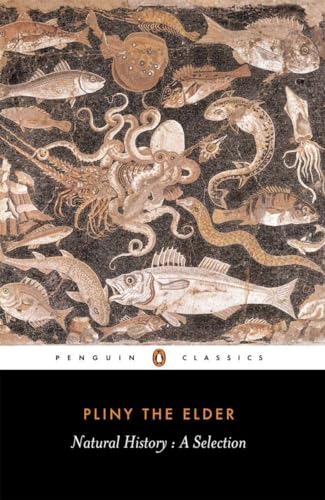

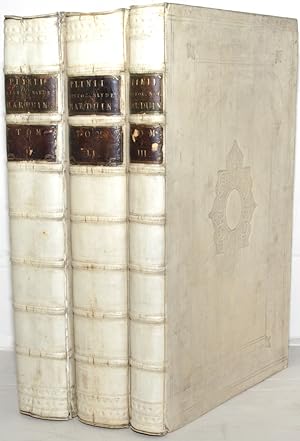

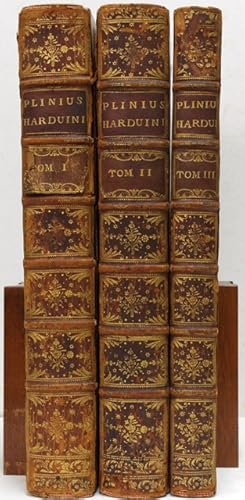
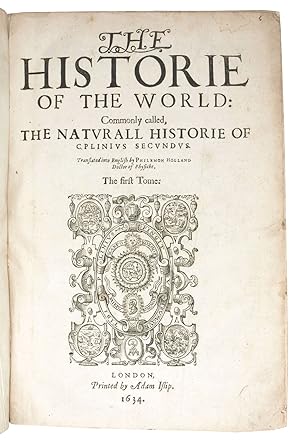
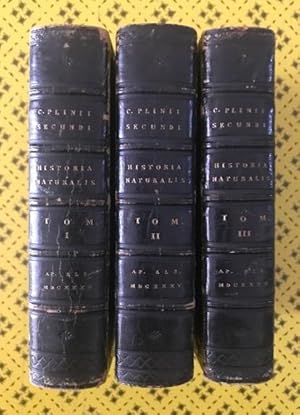
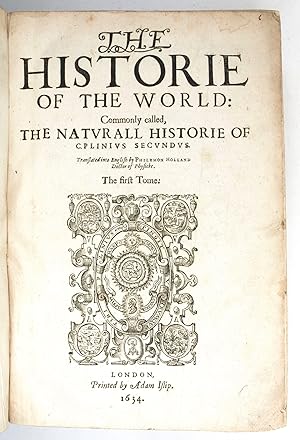



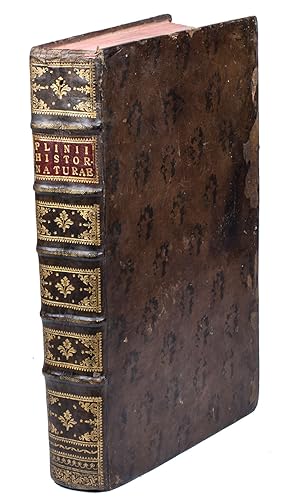
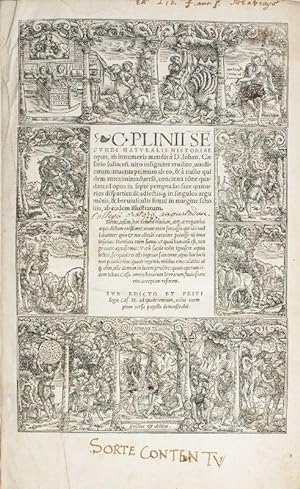
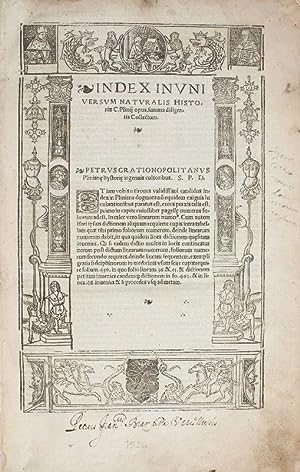
![Bild des Verkäufers für [Incunabula] C. Plyniise Cundinaturaehi by Pliny, the Elder [Gaius Plinius Secundus] zum Verkauf von Blind-Horse-Books (ABAA-FABA-IOBA)](https://pictures.abebooks.com/inventory/md/md31116164992.jpg)